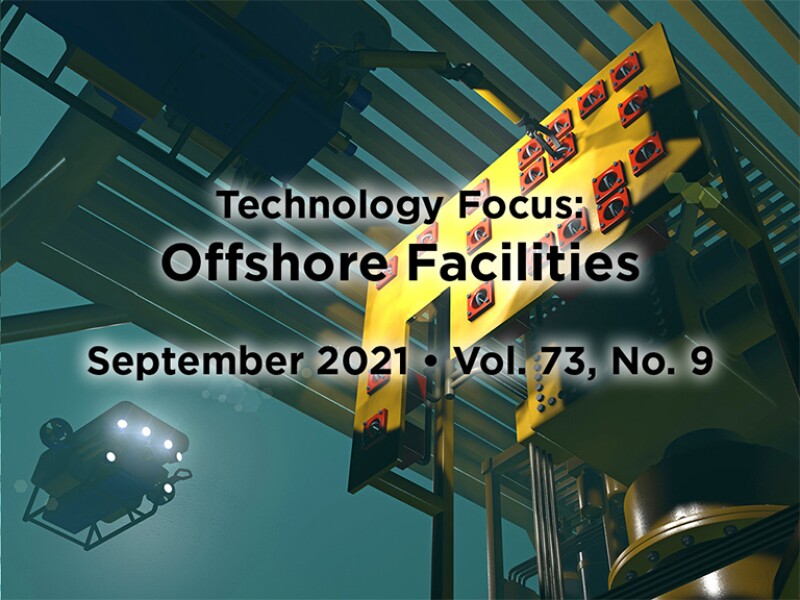For this feature, I have had the pleasure of reviewing 122 papers submitted to SPE in the field of offshore facilities over the past year. Brent crude oil price finally has reached $75/bbl at the time of writing. So far, this oil price is the highest since before the COVID-19 pandemic, which is a good sign that demand is picking up. Oil and gas offshore projects also seem to be picking up; most offshore greenfield projects are dictated by economics and the price of oil. As predicted by some analysts, global oil consumption will continue to increase as the world’s economy recovers from the pandemic. A new trend has arisen, however, where, in addition to traditional economic screening, oil and gas investors look to environment, social, and governance considerations to value the prospects of a project and minimize financial risk from environmental and social issues.
The oil price being around $75/bbl has not necessarily led to more-attractive offshore exploration and production (E&P) projects, even though the typical offshore breakeven price is in the range of $40–55/bbl. We must acknowledge the energy transition, while also acknowledging that oil and natural gas will continue to be essential to meeting the world’s energy needs for many years. At least five European oil and gas E&P companies have announced net-zero 2050 ambitions so far.
According to Rystad Energy, continuous major investments in E&P still are needed to meet growing global oil and gas demand. For the past 2 years, the global investment in E&P project spending is limited to $200 billion, including offshore, so a situation might arise with reserve replacement becoming challenging while demand accelerates rapidly. Because of well productivity, operability challenges, and uncertainty, however, opening the choke valve or pipeline tap is not as easy as the public thinks, especially on aging facilities.
On another note, the technology landscape is moving to emerging areas such as net-zero; decarbonization; carbon capture, use, and storage; renewables; hydrogen; novel geothermal solutions; and a circular carbon economy. Historically, however, the Offshore Technology Conference began proactively discussing renewables technology—such as wave, tidal, ocean thermal, and solar—in 1980.
The remaining question, then, is how to balance the lack of capital expenditure spending during the pandemic and, to some extent, what the role of offshore is in the energy transition. Maximizing offshore oil and gas recovery is not enough anymore. In the short term, engaging the low-carbon energy transition as early as possible and leading efforts in decarbonization will become a strategic move.
Leveraging our expertise in offshore infrastructure, supply chains, sea transportation, storage, and oil and gas market development to support low-carbon energy deployment in the energy transition will become vital. We have plenty of technical knowledge and skill to offer for offshore wind projects, for instance. The Hywind wind farm offshore Scotland is one example of a project that is using the same spar technology as typical offshore oil and gas infrastructure. Innovation, optimization, effective use of capital and operational expenditures, more-affordable offshore technology, and excellent project management, no doubt, also will become a new normal offshore.
This Month’s Technical Papers
Debottlenecking Approach Revitalizes Aging Platform by Increasing Production 30%
Life-Extension Project Applies Assessment of Reinforced Concrete to Nonjacket Structures
Optimization Process Maximizes Financial, Environmental Benefits in LNG Breakwater
Recommended Additional Reading
SPE 202911 Harnessing Benefits of Integrated Asset Modeling for Bottleneck Management of Large Offshore Facilities in the Matured Giant Oil Field by Yukito Nomura, ADNOC, et al.
OTC 30970 Optimizing Deepwater Rig Operations With Advanced Remotely Operated Vehicle Technology by Bernard McCoy Jr., TechnipFMC, et al.
OTC 31089 From Basic Engineering to Ramp-Up: The New Successful Execution Approach for Commissioning in Brazil by Paulino Bruno Santos, Petrobras, et al.

Ardian Nengkoda, SPE, is a facilities development lead at Saudi Aramco. He works as group leader for offshore-facilities development, including in field development, facilities-concept selection, flow assurance, production-chemistry risk, and project management. Nengkoda is a member of the Saudi Aramco Petroleum Engineering Technologist Development/Technical Review Committee, Composition and Development Review for Field Development Committee, and Oil and Gas Process Engineering Standards Committee. He has more than 24 years of experience in the upstream oil and gas industry, and, before joining Saudi Aramco in 2012, he worked for PDO, Shell, Schlumberger, and Unocal. Nengkoda is a recipient of the 2015 SPE Regional Projects, Facilities, and Construction Award and the 2014 Gas Processors Association (GPA) GCC Best Paper Award. He holds a BS degree in gas engineering from the University of Indonesia and MEng and PhD degrees in chemical engineering from Gadjah Mada University. Nengkoda is a member of the JPT Editorial Review Committee and the SPE International Energy Information Committee. He can be reached at ardian.nengkoda@aramco.com.

